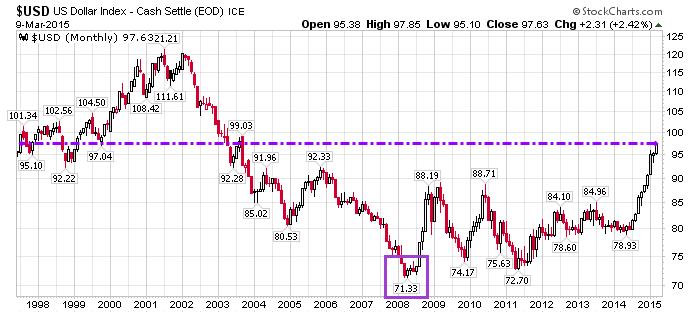This post is a followup on the alleged US dollar shortage thesis as well as further discussion of the Yuan, and the Yen.
Let’s start with a recap of the US dollar debate, after which I will tie up some loose ends.
US Dollar Margin Call Shortage Thesis
On March 8, ZeroHedge commented The Global Dollar Funding Shortage Is Back With A Vengeance And “This Time It’s Different”.
ZeroHedge wrote “The last time the world was sliding into a US dollar shortage as rapidly as it is right now, was following the collapse of Lehman Brothers in 2008. As we discussed back then, this systemic dollar shortage was primarily the result of imbalanced FX funding at the global commercial banks, arising from first Japanese, and then European banks’ abuse of a USD-denominated asset-liability mismatch, in which the dollar being the funding currency of choice, resulted in a massive matched synthetic ‘Dollar short’ on the books of commercial bank desks around the globe: a shortage which in the aftermath of the Lehman failure manifested itself in what was the largest global USD margin call in history.“
No Shortage Thesis
On March 11, I replied to the above idea with The Global Dollar Funding Shortage Is Back With A Vengeance And “This Time It’s Different”Â
 “I do not believe there is a dollar shortage or even a synthetic dollar shortage. More importantly, a dollar shortage certainly did not cause the crash in 2008. Excess debt and speculation caused the crisis in 2008. Any alleged or apparent dollar shortage was a result, not a cause of the crash.”
Demand for Dollars
It’s amusing to discuss currency shortages given all the central banks are or have been flooding the markets with currency in an inane attempt to cure a debt problem by forcing more debt into the system.
I discussed this on Monday in Draghi’s Goal: Higher inflation and Negative Yields; ECB’s Asset Purchases to Outstrip Supply 3-1; Is There a Catch?
That interest rates are negative in Germany for every duration from one month through six years (only two basis points from seven) speaks for itself. There is no demand for loans relative to supply of euros from the ECB.
Same as 2008 or Opposite?
The US dollar index is at roughly the same level as in 1998, also 1988 (not shown). The peak in 1985 was 164.72. The peak in 2001 was 121.21.
Lehman Bankruptcy
On September 15, 2008, Lehman filed for bankruptcy. The dollar bottom was in April of 2008, at 71.33.
At that time, anti-US$ sentiment was massively in vogue.
The Schiff’s of the world were screaming hyperinflation. Today, US hyperinflationists are thoroughly discredited and in hiding.
Today, nearly everyone loves dollars and hates gold. Dollar swaps that were not in place then, are in place now. All things considered, conditions are nearly the opposite of 2008.
Acting Man Chimes In
Pater Tenebrarum at the Acting Man blog contributed to my reply. Then on March 12, Tenebrarum did his own followup: The Dollar Squeeze – How Problematic Is It?
“The visible currency effects (such as a soaring dollar exchange rate and funding gaps, see below) are usually mainly a consequence, not a cause of crisis conditions. Of course, the recent rise in the dollar was initially triggered by perceptions of monetary policies between the US and other currency areas diverging – everybody expects the Fed to hike rates, while rates are being lowered everywhere else. It should be added to this that there are of course feedback loops at work: the stronger the dollar becomes, the more difficult it will be for dollar debtors abroad to service their debt, so any future crisis situation will tend to feed on itself. Note in this context that if a debtor has hedged his dollar exposure, the associated currency risk has not disappeared – it has merely been shifted to his counterparty.”Â
Tenebrarum provides many charts in his explanation. I caution that it’s not light reading to say the least. Then again, money in general is nearly always a complex read.
$9 Trillion Stress Test
On March 11, Ambrose Evans-Pritchard at the Telegraph chimed in with Global Finance Faces $9 Trillion Stress Test as Dollar Soars.Â


